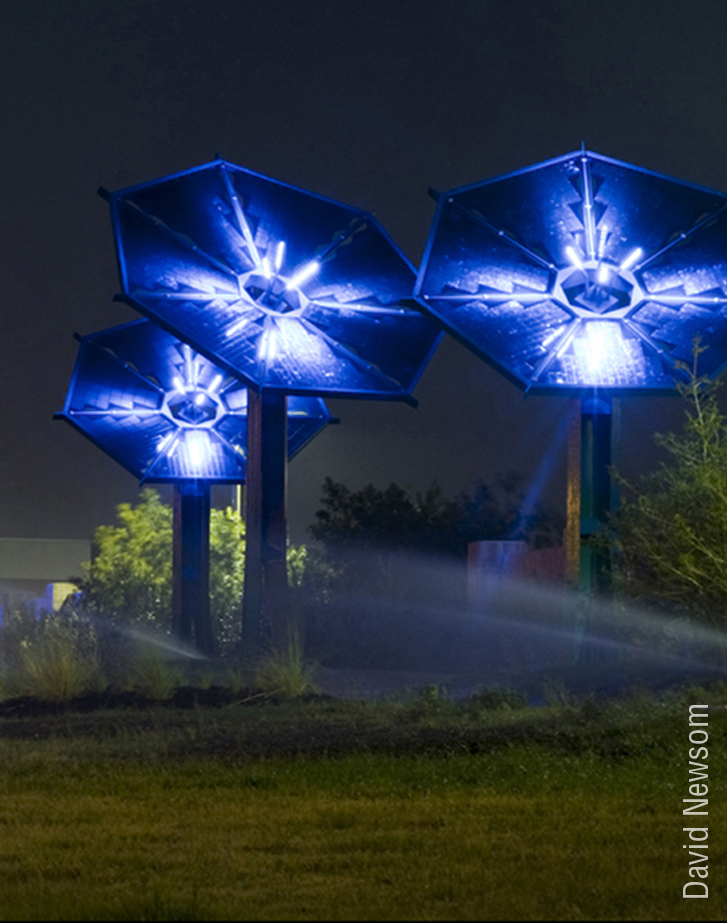Honoring the Future’s inaugural “Climate SmART” education program opened to acclaim from the Philadelphia Inquirer on April 16, 2014. Cosponsored by the Penn School of Social Policy and Practice, the program, which was free and open to the public, featured four artists presenting art they had produced in response to climate change:
- Paula Winokur, an internationally renowned sculptor whose work has been in the permanent collection of 17 museums, including such prestigious venues as the Philadelphia Museum of Art, Smithsonian Institution’s Renwick Gallery, and the Houston Museum of Fine Arts.
- Eve Mosher, an interactive public projects artist and creator of the HighWaterLine projects in New York City and Philadelphia. Her work has been profiled in the New Yorker, New York Times, Miami Herald, and Le Monde, among other publications.
- Peter Handler, an accomplished craft artist whose work was deemed “Best in Show” at the preeminent Smithsonian Craft Show. He is currently creating a series of sculptural pieces collectively titled “The Canaries in the Coal Mine,” drawing attention to the places and wildlife endangered by climate change.
- Lillian Ball, an internationally recognized environmental artist, creator of sustainable green infrastructure projects (including WATERWASH®, a wetlands park on the Bronx River), and recipient of fellowships and awards from the National Endowment for the Arts and New York State Foundation for the Arts.
These artists’ work “provides another entry point for people whose eyes glaze over at the mention of how experts are now measuring up to 400 parts per million of carbon dioxide in the atmosphere, up from 280 in the late 1700s” wrote Inquirer Staff Writer Sandy Bauers.
Panel moderator Fran Dubrowski likened climate change art to the music of the 1960s which “propelled a lot of cultural change.” “Here, the visual component is what’s so important,” Dubrowski said. “Most Americans don’t get to the Arctic or Antarctica. It’s really hard for them to understand the scope of what is happening. But when you see James Balog’s time-lapse photographs of a glacier shrinking or Eve Mosher’s chalk line showing where the high water line is going to be as sea levels rise, you can see, feel, and understand climate change. That’s what artists do.”
A second “Climate SmART” program opened the Boston College Arts Festival on April 24, 2014, cosponsored by the University’s Environmental Studies Program and college organizations. In addition to Peter Handler and Lillian Ball, that program featured:
- Mags Harries, a faculty member of the School of Boston Museum of Fine Arts, who partnered with artist/architect Lajos Heder to create nationally recognized, award-winning public art projects focused on water, energy, transportation, and physical and performance elements connecting people and communities.
- Jane Marsching, an interdisciplinary artist and Associate Professor and Sustainability Fellow at Massachusetts College of Art and Design, whose work has been exhibited at Boston’s Institute of Contemporary Art; MassMoCA; the North Carolina Museum of Art; and San Jose, California Museum of Art.
Like its Philadelphia predecessor, the Boston program explored how artists are tackling the complex subject of climate change, pointing the way towards prepared, resilient, “climate smART” communities. The program also examined how each of us can contribute our individual talents to address the climate challenge – a discussion the Boston College Arts Council acknowledged “might be this generation’s most important conversation.”
Honoring the Future plans to take additional “Climate SmART” programs to communities across the nation in the months to come.

